To visit - Marrakech
Marrakech: A Journey into Moroccan Splendor
Marrakech, often referred to as the "Red City" of Morocco, is an alluring blend of rich history and vibrant culture. Immerse yourself in its UNESCO-listed Medina, a captivating maze of bustling souks and the lively Jemaa el-Fnaa square, where storytellers and musicians create a mesmerizing spectacle.
Discover the city's architectural treasures, from the intricately designed Bahia Palace to the historic Saadian Tombs. The iconic Koutoubia Mosque stands tall with its majestic minaret, a symbol of Marrakech's heritage.
Culinary enthusiasts will delight in the diverse flavors of Moroccan cuisine, found in the savory tagines, aromatic spices, and sweet pastries available in local markets and eateries.
Marrakech is a haven for art and culture, boasting galleries such as Maison de la Photographie and the Museum of Marrakech. For an authentic experience, consider staying in a traditional riad, where serene courtyards and rooftop terraces offer an oasis of calm.
Use Marrakech as a gateway for exciting day trips, whether it's exploring the Atlas Mountains, visiting the UNESCO-listed Ait Ben Haddou, or experiencing the tranquility of the Ourika Valley.
The Majorelle Garden, with its cobalt blue structures and lush botanicals, provides a serene escape from the city's vibrant energy. Marrakech comes alive during sunset, casting a warm glow over its historical landmarks and dynamic street life.
In Marrakech, every corner tells a story, and every experience is a sensory delight, making it a destination that lingers in the memories of those who wander its captivating streets.
The 13 essential things to do in Marrakech. :
Summary
- To visit
-
- 1 - Walk in the Medina
- 2 - Visit to Jemaa el-Fna square
- 3 - Excursion to the Majorelle Gardens
- 4 - Relaxation in a hammam
- 5 - Visit to the Bahia Palace
- 6 - Discovery of the Saadian Tombs
- 7 - Hiking in the Atlas Mountains
- 8 - Dinner in a Riad
- 9 - Camel ride
- 10 - Day trip to Essaouira
- 11 - The Agdal and Menara Gardens
- 12 - Agafay Desert and Sunset
- 13 - the Berber villages of the Ourika valley
- Marrakech - Where to Stay?
- Marrakech - How to get around?
- Marrakech - Best period
1 - Walk in the Medina
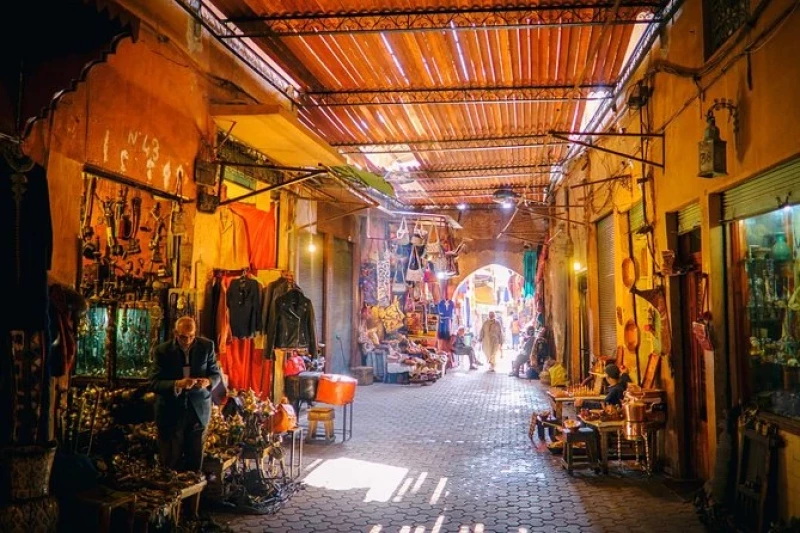
A mesmerizing stroll through Marrakech's Medina provides a captivating journey into Moroccan history and culture. Starting at the lively Jemaa el-Fna Square, where storytellers, musicians, and vendors infuse the atmosphere with energy, the journey heads towards Rue Riad Zitoun el-Jedid, offering a less touristy glimpse into local life. The exploration of the opulent Bahia Palace, with its lavish courtyards and lush gardens, enchants the senses. The walk continues through the maze-like souks, where stalls brimming with spices, carpets, and Moroccan craftsmanship add vibrant hues to narrow alleyways.
The Mouassine Fountain, a symbol of history and tranquility, provides a moment of respite before delving into Rue Bab Doukkala, less frequented but rich in authenticity. The Mouassine Mosque, with its ancient architecture, adds a spiritual touch to the journey. Continuing towards the hidden Jardins de la Médina, concealed behind unassuming walls, reveals green oases perfect for relaxation. The loop eventually concludes back at Jemaa el-Fna Square, where one can settle into a terrace café, sipping mint tea while observing the lively ballet of daily life in Marrakech. This stroll offers a comprehensive immersion into the Medina, blending the hustle of the souks with the serenity of gardens, capturing the vibrant essence of this magical city.
 Our tips for getting the most out of your experience.
Our tips for getting the most out of your experience.
When planning a stroll through Marrakech's Medina, it's helpful to consider some tips to enhance your experience:
-
Dress appropriately: Wear modest clothing, especially if you plan to visit religious sites. Shoulders and knees should be covered to respect local tradition.
-
Choose comfortable footwear: The alleys of the Medina can be paved and sometimes uneven. Comfortable shoes are essential for a hassle-free walk.
-
Negotiate at the souk with respect: Haggling is common in the souks. Be respectful, friendly, and don't be shy about negotiating the price. It's an integral part of the local culture.
-
Be aware of your surroundings: The Medina can be lively and sometimes chaotic. Be attentive to your belongings and make sure you know where you're going. It's easy to get lost in the maze of alleyways.
-
Know when to visit tourist sites: Some sites may be more crowded at certain times of the day. Try to plan your stroll to avoid peak hours.
-
Respect the privacy of locals: Some areas of the Medina are residential neighborhoods. Avoid taking photos without permission and be aware that you are exploring the homes of many residents.
-
Taste local cuisine: Enjoy street food stalls and small restaurants to discover delicious Moroccan cuisine. Try traditional dishes such as tagine and local pastries.
-
Be prepared to negotiate guide services: If you want to explore the Medina with a guide, be ready to negotiate rates. It can be an excellent way to gain local insights and not miss out on anything.
-
Use visual landmarks: The Medina can be confusing with its winding streets. Use visual landmarks to orient yourself, such as mosque minarets or historic gates.
-
Appreciate the local pace: The Medina has its own rhythm. Take the time to appreciate the atmosphere, stop for mint tea, and observe the daily life of the locals.
By following these tips, you can fully enjoy your stroll through Marrakech's Medina while respecting the local culture.
2 - Visit to Jemaa el-Fna square
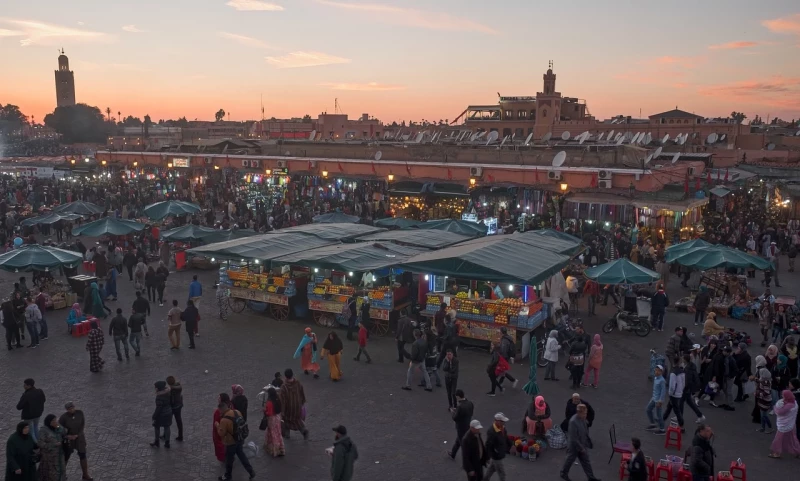
Jemaa el-Fna Square in Marrakech is a vibrant epicenter of culture and activity, offering an immersive experience into the heart of Moroccan life. As the day unfolds, the square transforms into a dynamic spectacle where storytellers, musicians, and performers captivate the crowds. The rhythmic beats of traditional music blend with the aromatic scents of spices, creating an intoxicating atmosphere that is quintessentially Moroccan.
During the day, the square is a bustling marketplace where locals and tourists alike peruse an array of stalls offering everything from spices and textiles to handicrafts. Snack on traditional street food like grilled meats, tagines, and freshly squeezed orange juice, embracing the culinary delights of the region.
As the sun sets, Jemaa el-Fna undergoes a magical metamorphosis. The square comes alive with the glow of countless lanterns, and the evening air is filled with the sounds of lively conversations and street performances. The aroma of Moroccan delicacies becomes even more tantalizing, beckoning visitors to explore the surrounding alleys and try local specialties from food stalls.
The perimeter of the square is lined with cafes and rooftop terraces, providing perfect vantage points to observe the vibrant scene below. These elevated spots offer panoramic views of the illuminated square, making it an ideal setting to unwind with a cup of traditional mint tea while absorbing the enchanting ambiance.
While Jemaa el-Fna is undoubtedly a major tourist attraction, it remains deeply ingrained in the daily life of Marrakech. Locals frequent the square to socialize, shop, and enjoy the diverse entertainment on offer. The UNESCO-listed square is not just a place; it's a living, breathing testament to the rich cultural tapestry of Marrakech, where ancient traditions and modern vibrancy coalesce in a captivating display of Moroccan identity.
 Our tips for getting the most out of your experience.
Our tips for getting the most out of your experience.
When visiting Jemaa el-Fna Square in Marrakech, here are some tips to enhance your experience:
-
Choose the right time of day: Jemaa el-Fna offers different experiences throughout the day. Visit in the late afternoon to enjoy the sunset and the lively evening atmosphere.
-
Negotiate with vendors: If you're making purchases on the square, be prepared to negotiate prices. It's a common practice in the souks and an integral part of the shopping experience.
-
Stay vigilant with your belongings: Due to the crowds, be attentive to your personal belongings, such as your handbag or camera. Vigilance is important to avoid any security issues.
-
Explore nearby alleys: Don't limit yourself to the main square. The surrounding alleys are filled with small shops, cafes, and hidden gems. Explore them to discover the true essence of the Medina.
-
Eat at food stalls: The food stalls on the square offer a variety of delicious Moroccan dishes. Try local specialties like kebabs, tagines, and pastries.
-
Set a meeting point: Due to the complexity of the square and the alleys, agree on a meeting point with your group in case you get separated. This will help avoid getting lost in the maze.
-
Be ready to be photographed: The square is often bustling with street performers and shows. Be ready to be photographed, but remember to ask for permission before taking pictures of locals.
-
Be open to interaction: The square is a social hub where locals gather. Be open to interacting with locals, whether it's chatting with vendors or enjoying the music and performances.
-
Avoid consuming alcohol on the square: Alcohol consumption is not common on Jemaa el-Fna Square. If you want a drink, look for cafes or restaurants that offer it.
-
Enjoy elevated viewpoints: For a panoramic view of the square, seek out the terraces of surrounding cafes and restaurants. It's an excellent way to step back and appreciate all the hustle and bustle.
By following these tips, you can fully enjoy your visit to Jemaa el-Fna and have an authentic experience at the heart of Marrakech.
3 - Excursion to the Majorelle Gardens
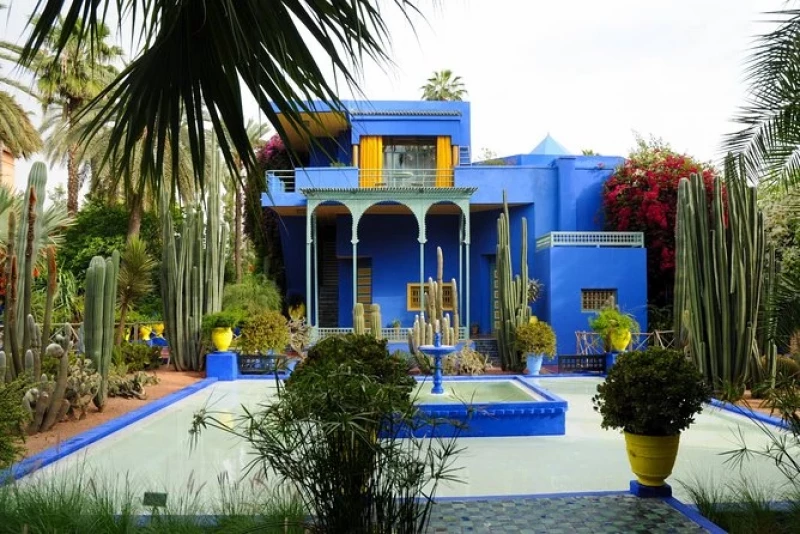
The Majorelle Gardens, nestled in the heart of Marrakech, constitute an enchanting botanical oasis that seamlessly blends artistic creativity with natural splendor. Conceived by the French painter Jacques Majorelle in the 1920s, the gardens unveil a vibrant color palette, with Majorelle blue hues prevalent in the buildings and structures.
The botanical diversity of the Majorelle Gardens is a source of wonder, housing exotic plants, striking cacti, and refreshing water basins. The serene atmosphere is enhanced by shaded pathways, blooming alleys, and murmuring fountains. The former residence of Jacques Majorelle, later owned by Yves Saint Laurent, adds a historical and artistic dimension to this lush space.
The garden also hosts the Berber Museum and the Yves Saint Laurent Museum, providing visitors with insights into Morocco's cultural richness and the legacy of the renowned fashion designer. The Majorelle Gardens, with their unique fusion of art, nature, and history, offer a tranquil escape in the heart of Marrakech, where one can lose oneself in visual beauty while experiencing the serenity that pervades this exceptional botanical haven.
 Our tips for getting the most out of your experience.
Our tips for getting the most out of your experience.
When embarking on an excursion to the Majorelle Gardens in Marrakech, consider the following tips to make the most of your visit:
-
Arrive early in the morning: The Majorelle Gardens are a popular attraction, so arriving early allows for a more peaceful experience with fewer crowds.
-
Purchase tickets in advance: If possible, buy your tickets in advance to avoid lines at the entrance of the gardens.
-
Respect the peaceful atmosphere: The Majorelle Gardens are known for their tranquil ambiance. Respect the serenity by avoiding excessive noise and being mindful of the surrounding nature.
-
Explore at your own pace: Take the time to wander through the winding pathways at your own pace. Allow yourself to soak in the beauty of the surroundings and discover hidden corners.
-
Visit the included museums: Take advantage of the opportunity to visit the Berber Museum and the Yves Saint Laurent Museum, both located within the gardens. They provide fascinating insights into the cultural history of Morocco and the artistic legacy of Yves Saint Laurent.
-
Protect yourself from the sun: The gardens can be sunny, so make sure to wear a hat, sunglasses, and protect yourself with sunscreen.
-
Photograph respectfully: The Majorelle Gardens are highly photogenic, but be sure to ask for permission before taking photos of people, especially locals.
-
Be prepared for a queue at the blue house: The blue house inside the gardens may have a queue. Be prepared to wait a bit if you wish to visit this iconic spot.
-
Respect dress codes: Like many sites in Morocco, dress modestly to adhere to cultural norms, especially if you plan to visit the museums.
-
Enjoy the peace of the on-site café: Conclude your visit by savoring a coffee at the Café des Jardins Majorelle. It's a tranquil spot to relax and reflect on the beauty of the gardens.
By following these tips, you can fully enjoy your excursion to the Majorelle Gardens and appreciate the tranquility and beauty of this exceptional site in Marrakech.
4 - Relaxation in a hammam
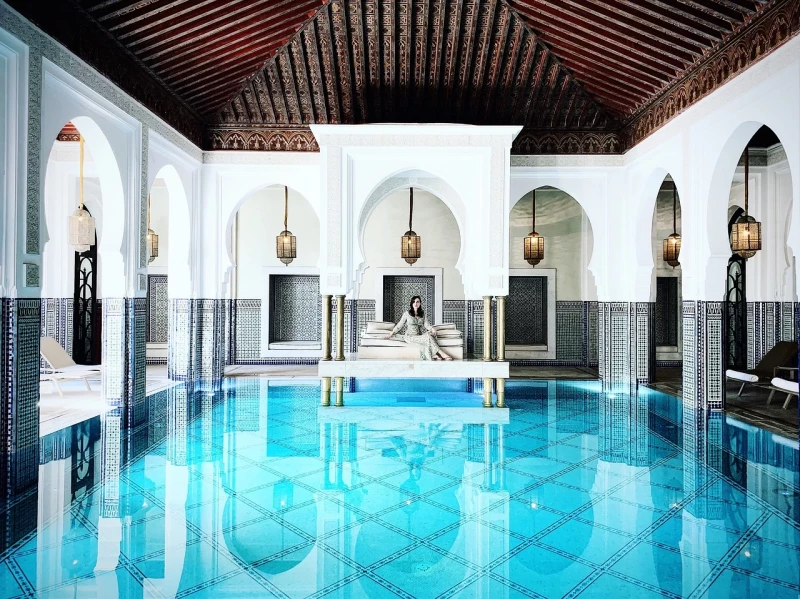
Relaxing in a hammam in Marrakech is a sensory journey that transports visitors to a haven of well-being steeped in ancient traditions. Upon entering, the captivating atmosphere of the hammam entices the senses with enveloping warmth, intoxicating eucalyptus scents, and the gentle murmur of water. The ritual begins with a relaxation phase, where the warm steam delicately prepares the skin to receive the benefits of the treatments.
The exfoliation with black soap, often performed with a kessa glove, becomes a purifying moment, eliminating impurities and reviving the skin's radiance. Clay masks, rich in minerals, nourish and revitalize. The session, much more than a mere physical treatment, offers a soothing meditation where stress evaporates in the soft and warm atmosphere of the hammam.
After the treatment, a refreshing shower or a cold water bath awakens the senses, stimulating circulation. Some hammams also offer relaxing massages, perfect for extending this sensory escape. It's an experience that transcends the body to touch the soul, leaving visitors not only with renewed skin but also with a profound inner relaxation. The magic of the Marrakech hammam lies in its ability to provide a refuge of tranquility, where the tumult of everyday life fades into the rediscovered harmony of body and mind.
 Our tips for getting the most out of your experience.
Our tips for getting the most out of your experience.
When indulging in relaxation at a hammam in Marrakech, here are some tips to maximize your experience:
-
Choose the right hammam: Marrakech offers a variety of hammams, from luxurious establishments to more traditional options. Do some research beforehand to find one that best suits your preferences.
-
Check mixed-gender hours: Some hammams have mixed-gender hours when both men and women can enjoy the facilities simultaneously. Make sure to be aware of these hours if you're traveling as a couple or in a mixed group.
-
Bring your own products: While many hammams provide basic amenities, bring your own toiletries, such as soap and a kessa glove, for a more personalized experience.
-
Avoid peak hours: For a quieter experience, steer clear of peak hours. Midweek mornings are often less crowded.
-
Hydrate before the session: The heat in the hammam can be dehydrating. Ensure you hydrate well before your session and afterward to maintain your body's water balance.
-
Respect dress traditions: Most hammams provide robes, but it's advisable to inquire about the specific dress traditions of the hammam you choose. Some may require swimwear.
-
Respect nudity norms: In many hammams, nudity is the norm. Be respectful of local customs and fellow visitors by adhering to the hammam's norms.
-
Take your time: Relaxing in a hammam is an experience to savor. Take your time to enjoy each step of the ritual, from the steam bath to the scrubbing and treatment.
-
Allow time for rest afterward: After your session, give yourself time to rest. Avoid rushing to other activities to prolong the benefits of your relaxation.
-
Tips for gratuities: In some hammams, it's customary to leave a tip for the staff providing the treatments. Make sure to check the hammam's policy in this regard.
By following these tips, you can fully enjoy your relaxation experience at a hammam in Marrakech, respecting local traditions and maximizing the soothing benefits of this ritual.
5 - Visit to the Bahia Palace
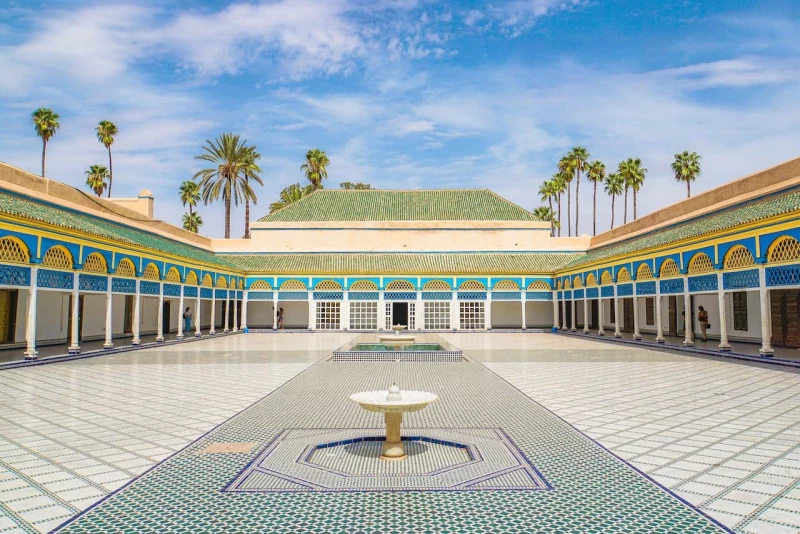
The Bahia Palace, located in the heart of Marrakech, is an architectural gem that reflects the opulence and refinement of the Arab-Andalusian era. Built in the late 19th century for the Grand Vizier Ahmed ben Moussa, the palace spans eight hectares and provides an immersion into Moroccan art and history. The name "Bahia" means "the beautiful," and the palace lives up to its name with its interior courtyards adorned with lush gardens, lavishly decorated lounges, and elegant fountains.
Visitors are captivated by the intricate architectural details, colorful zellige tiles, finely carved cedar wood ceilings, and delicately latticed moucharabieh screens. The quarters of the concubines, audience halls, and expansive courtyards offer a glimpse into the palatial life of the time. The layout of the palace, with its numerous rooms, mysterious corridors, and secret passages, creates an enchanting atmosphere that transports visitors to another era.
The garden of the Bahia Palace, with its rose beds, orange trees, and palm groves, is an oasis of tranquility where one can escape the hustle and bustle of the surrounding medina. Every corner of the palace tells a story, making the visit an immersive experience that blends architectural aesthetics, cultural history, and wonder at the splendor of a bygone era. The Bahia Palace remains a shining testament to Moroccan art and craftsmanship, drawing visitors from around the world into its enchanting realm.
 Our tips for getting the most out of your experience.
Our tips for getting the most out of your experience.
When visiting the Bahia Palace in Marrakech, here are some tips to make the most of your experience:
-
Arrive early: To avoid crowds, try to visit the palace early in the morning. This allows you to fully enjoy the experience without being rushed by the crowd.
-
Hire a local guide: A local guide can provide in-depth historical and cultural information, enhancing your visit. They can also help you navigate through the different parts of the palace.
-
Study the history before the visit: Having a prior understanding of the palace's history and architecture will allow you to better appreciate the details during your visit.
-
Explore at your own pace: Bahia Palace is vast, with many corners to discover. Take your time to explore each courtyard, each room, and fully enjoy the unique atmosphere of the place.
-
Observe architectural details: The architectural details of the palace are stunning. Pay attention to the colorful zelliges, finely carved ceilings, and artistic elements that contribute to the palace's beauty.
-
Visit the gardens: Don't overlook the palace gardens. They are peaceful and offer a beautiful view of the surrounding architecture. It's an ideal spot to relax.
-
Photograph respectfully: Make sure to ask for permission before taking photos, especially if it involves people. Respect areas where photography may be limited.
-
Dress appropriately: Due to the cultural nature of the site, dress modestly. This may involve covering your shoulders and knees.
-
Stay hydrated: Marrakech can be very hot, especially during the summer. Ensure you stay hydrated by bringing a water bottle during your visit.
-
Avoid peak days: If possible, avoid visiting the palace on peak days, such as weekends, for a more peaceful experience.
By following these tips, you can fully appreciate your visit to the Bahia Palace and make the most of it while respecting local traditions.
6 - Discovery of the Saadian Tombs
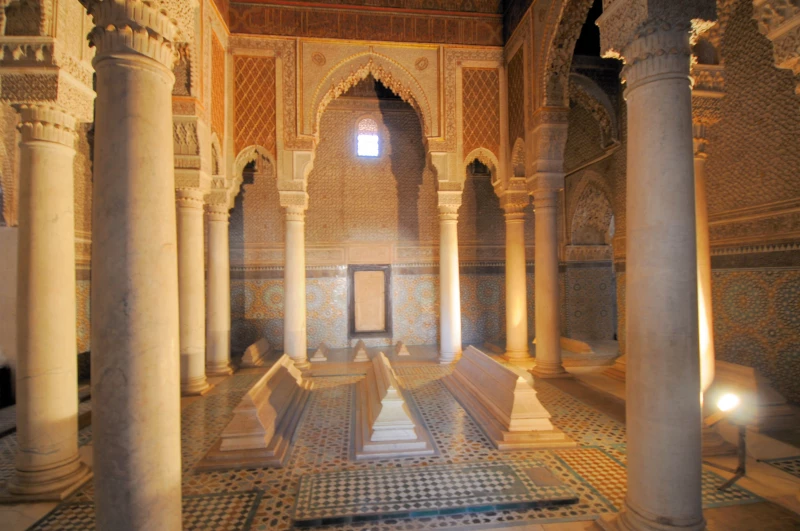
The Saadian Tombs in Marrakech are a true historical gem, providing visitors with a captivating journey through Morocco's past. Built in the 16th century, these tombs are a remarkable example of Moorish architecture, showcasing exquisite artistic elements such as zellige tilework, Islamic calligraphy, and finely carved cedar wood ceilings.
The tombs house the burial grounds of members of the Saadian dynasty, including Sultan Ahmed al-Mansur, and were rediscovered in the early 20th century after being neglected for centuries. The main chambers, like the Hall of Twelve Pillars, exude a mystical and solemn atmosphere. The surrounding gardens add a sense of serenity to the entire complex, with shaded pathways and fragrant roses.
A visit to the Saadian Tombs provides a unique opportunity to connect with Morocco's glorious past and witness the deep respect the Saadian dynasty held for their deceased. The palpable history within these walls, combined with exceptional artistic craftsmanship, creates an experience that transcends time, transporting visitors to a bygone era of royal splendor and remarkable architectural tradition. The Saadian Tombs are a must-visit for history enthusiasts or those appreciative of artistic beauty, offering a poignant glimpse into Morocco's heritage.
 Our tips for getting the most out of your experience.
Our tips for getting the most out of your experience.
When exploring the Saadian Tombs in Marrakech, here are some tips for an enriching experience:
-
Visiting hours: Plan your visit early in the morning to avoid crowds, allowing you to better appreciate the beauty and tranquility of the site.
-
Local guide: Hire a local guide to gain in-depth insights into the history and architectural details of the tombs. This will add an extra dimension to your experience.
-
Prior knowledge: Familiarize yourself with the history of the tombs before your visit. This will help you better appreciate the cultural and historical significance of the site.
-
Photography: Respect photography rules. Some areas may have restrictions, so be sure to ask for permission before taking photos.
-
Quiet moments: Try to visit the tombs early or late in the day to enjoy quiet and intimate moments in this historical place.
-
Explore the surroundings: Take advantage of the surrounding gardens after visiting the tombs. The gardens add a peaceful dimension to the overall experience.
-
Dress code: Dress modestly out of respect for the sacred nature of the site. Avoid overly casual attire.
-
Hydration: Bring a water bottle, especially if you're visiting during the hot hours of the day. Marrakech can get quite warm.
-
Contemplation time: Take the time to sit and contemplate the architectural details, inscriptions, and the serene atmosphere of the tombs.
-
Respect local customs: Be respectful of local customs. The tombs are a historic and sacred place, so adopt a respectful demeanor during your visit.
By following these tips, you can make the most of your exploration of the Saadian Tombs, fully appreciating the history and cultural beauty of this iconic site in Marrakech.
7 - Hiking in the Atlas Mountains
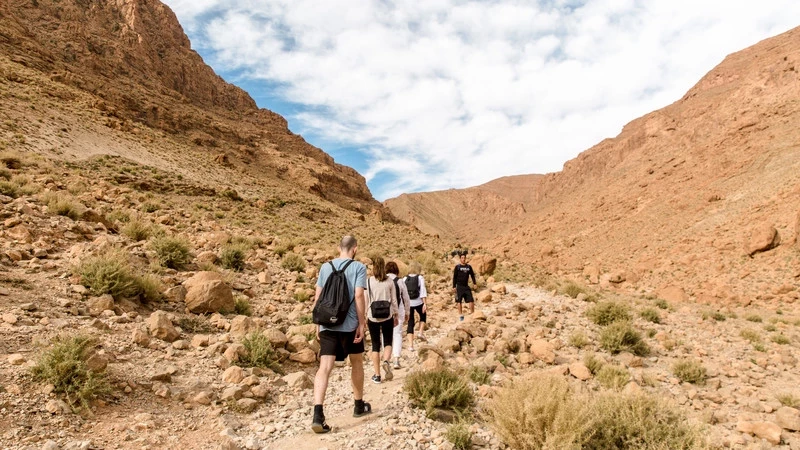
Hiking in the majestic Atlas Mountains of Morocco offers a captivating experience, blending natural splendor with a deep immersion into Berber culture. Snow-capped peaks, lush valleys, and picturesque Berber villages create a breathtaking tableau throughout the journey.
Hiking trails wind through diverse landscapes, providing breathtaking panoramic views. Hikers can explore the richness of local flora and fauna while venturing into remote valleys. Encounters with locals are an essential part of this experience, offering a unique perspective on mountain life and traditions rooted for generations.
Mountain refuges welcome hikers, providing well-deserved rest and unforgettable starlit evenings. Ascending iconic peaks such as Toubkal, the highest point in the Atlas, rewards hikers with spectacular views that evoke a sense of accomplishment.
The Atlas Mountains are a living canvas where adventure blends with cultural discovery, creating lasting memories. Hiking in these majestic mountains is an invitation to explore Morocco's pristine nature while forging authentic connections with a resilient and welcoming mountain community.
 Our tips for getting the most out of your experience.
Our tips for getting the most out of your experience.
When hiking in the Atlas Mountains of Morocco, here are some tips for an enjoyable and enriching experience:
-
Ideal Season: Choose the right time of the year. Spring and fall are often considered the best seasons for hiking, avoiding the extreme summer temperatures and harsh winter conditions.
-
Appropriate Gear: Ensure you have the right equipment, including sturdy hiking boots, layered clothing, a waterproof jacket, and a comfortable backpack to carry essential items.
-
Local Guide: Hire a local guide to navigate the trails. Atlas Mountain trails can be intricate, and an experienced guide can not only show you the way but also share insights into local culture and wildlife.
-
Hydration and Nutrition: Bring an ample supply of water, as hiking at altitude can lead to rapid dehydration. Pack energy snacks to sustain your energy levels throughout the day.
-
Altitude Acclimatization: If you plan to reach high altitudes, make sure to acclimatize gradually to avoid altitude sickness.
-
Respect the Environment: Follow the principles of "Leave No Trace." Respect nature, pack out your waste, and avoid disturbing local wildlife.
-
Permits and Permissions: Check if permits or special permissions are required for certain hiking areas. Some places may have strict conservation rules.
-
Prepare for Weather Changes: Mountain weather conditions can change rapidly. Be prepared for wind, rain, and variable temperatures.
-
Health Check: Ensure you are in good health before hiking at altitude. Consult a healthcare professional if you have medical concerns.
-
Interact with Locals: Take the time to interact with the inhabitants of the villages you pass through. This can enhance your cultural experience and create authentic connections.
By following these tips, you can fully enjoy your hiking experience in the Atlas Mountains while ensuring your safety and respecting the environment and local culture.
8 - Dinner in a Riad
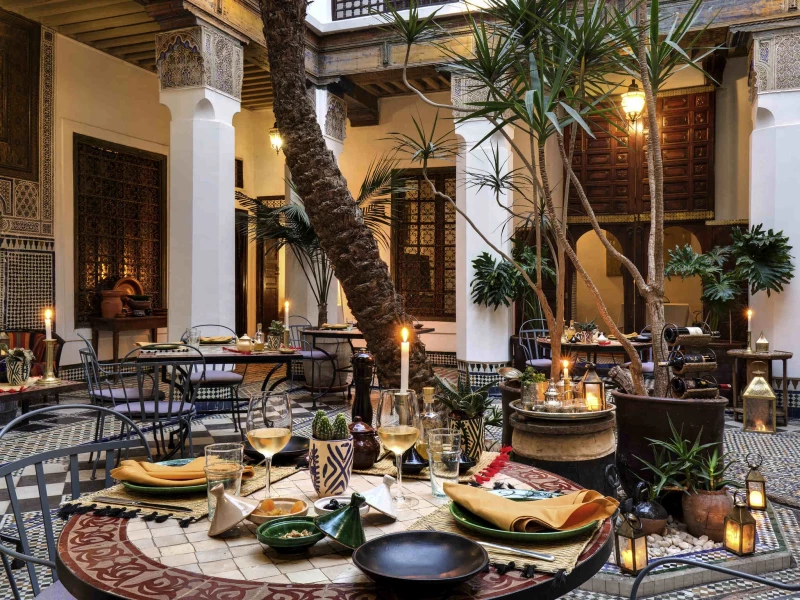
Dining in a riad in Marrakech is an immersive sensory experience, blending the elegance of traditional Moroccan architecture with delectable local cuisine. Riads, often concealed behind modest doors in the medina, offer an oasis of tranquility away from the bustle of the surrounding streets.
The meal typically begins with an array of appetizers, including marinated olives, fresh salads, and traditional breads. Main courses feature flavorful tagines, richly adorned couscous, and succulent grilled meats. The exquisite flavors of Moroccan cuisine are accentuated by the use of spices such as saffron, cumin, and cinnamon.
The table is often set in patios adorned with zellige tiles and soothing fountains, creating an intimate and warm atmosphere. The glow of lanterns contributes to a magical ambiance, while traditional Moroccan music adds an authentic touch.
Riads also emphasize attentive service, offering warm hospitality and knowledgeable advice on local dishes. Dining in a riad transcends the mere act of eating to become a celebration of Moroccan culture, where each dish tells a story, and every corner of the riad reveals timeless beauty. It's an experience that nourishes not only the body but also the soul, leaving lasting memories of an enchanted evening in Marrakech.
 Our tips for getting the most out of your experience.
Our tips for getting the most out of your experience.
When planning to have dinner in a riad in Marrakech, here are some tips to enhance your experience:
-
Early Reservation: Popular riads may fill up, especially during the high season. Book your dinner in advance to secure a spot.
-
Dress Code: Some riads may have a casual dress code, while others may require a more formal attire. Inquire in advance and dress accordingly.
-
Meal Times: Meal times in Morocco may differ from those in other countries. Check the riad's opening hours and ensure you arrive on time.
-
Vegetarian or Special Options: If you have dietary preferences or restrictions, inform the riad at the time of booking. Most establishments will be happy to accommodate.
-
Menu Choices: Take the opportunity to try traditional Moroccan dishes such as tagine, couscous, and grilled meats. It's a great way to explore the local cuisine.
-
Ask for Recommendations: Feel free to ask the riad staff for recommendations on popular dishes or house specialties.
-
Musical Ambiance: Some riads offer traditional musical performances during meals. Check if they have such entertainment and enjoy it for a more immersive experience.
-
Inquire about Drinks: Some riads may not serve alcohol due to local restrictions. If this is important to you, make sure to check in advance or bring your own wine.
-
Allow Plenty of Time: Dinners in riads are often leisurely experiences. Allow ample time to savor each course and soak in the unique atmosphere.
-
Express Preferences: Don't hesitate to communicate your preferences to the riad staff, whether it's regarding your table location, dietary preferences, or any other specific details.
By following these tips, you can ensure you make the most of your dinner in a riad, creating a memorable culinary experience in Marrakech.
9 - Camel ride
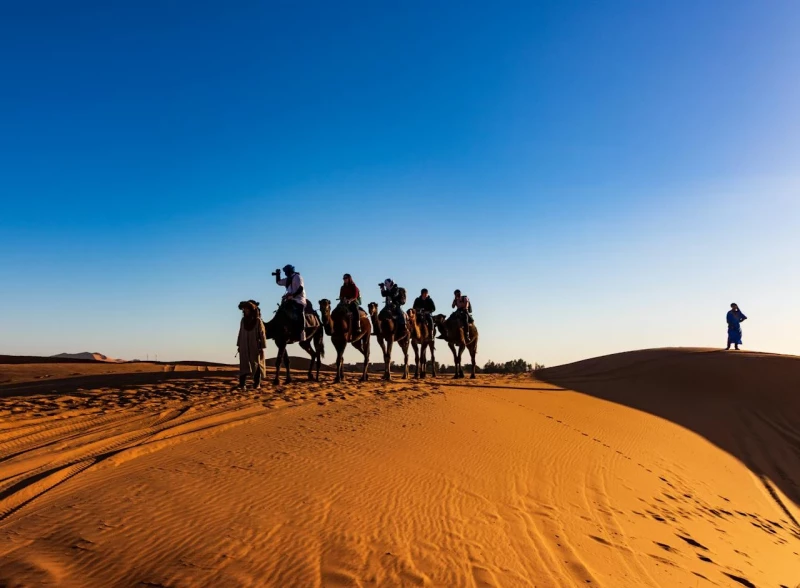
Camel riding in Marrakech is an unforgettable experience that transports visitors to another era, evoking the charm of the desert and nomadic culture. Camels, graceful and majestic, provide a unique way to explore the surrounding landscapes, whether on the outskirts of the Agafay Desert or along the palm groves.
Camel rides often begin in desert areas near Marrakech, where undulating dunes create a spectacular backdrop. The leisurely pace of the camel allows travelers to fully appreciate the panoramic views and capture the essence of the Moroccan landscape.
Camel guides, often from Berber families, generously share their knowledge of the region, providing insights into local traditions and nomadic life. Camel rides can be arranged at sunset, creating a magical ambiance as the sun sets over the desert landscape.
The camel riding experience is not only a picturesque adventure but also a dive into the cultural richness of Morocco. Whether for a day trip or a sunset excursion, camel riding in Marrakech remains an iconic experience, offering an authentic connection with nature and Moroccan tradition.
 Our tips for getting the most out of your experience.
Our tips for getting the most out of your experience.
When embarking on a camel ride in Marrakech, here are some tips to make your experience even more enjoyable:
-
Book in Advance: Make sure to book your camel ride in advance, especially if you have a specific time in mind. This will ensure availability and prevent disappointments.
-
Wear Appropriate Clothing: Opt for comfortable and lightweight clothing suitable for local weather conditions. Don't forget to bring a hat and sunglasses to protect yourself from the sun.
-
Bring Water: Staying hydrated is crucial, especially in Marrakech's warm climate. Bring a water bottle to ensure you remain well-hydrated during the camel ride.
-
Apply Sunscreen: Protect your skin from the sun by applying sunscreen before the ride. The sun's rays can be strong, even during a short excursion.
-
Listen to Camel Guides: Pay attention to the advice of your camel guide. They are often well-informed about camel behavior and can provide important insights for a more enjoyable experience.
-
Bring a Camera: Don't forget to bring your camera or smartphone to capture memorable moments of your camel ride and the stunning surrounding landscapes.
-
Stretch Before the Ride: Camel rides can be a bit stiff for some. Do some light stretches before the ride to ensure you are comfortable during the journey.
-
Respect the Camels: Be respectful to the camels. Avoid pulling on the reins or disturbing them. Well-treated animals are more likely to offer a pleasant experience.
-
Choose the Right Time of Day: Early morning or late afternoon rides are often more pleasant as temperatures are milder, and the light is beautiful.
-
Negotiate the Price: If you haven't booked in advance, feel free to negotiate the price of the camel ride. However, be fair and respectful of local rates.
By following these tips, you'll maximize your enjoyment during your camel ride in Marrakech, creating lasting memories of this unique experience.
10 - Day trip to Essaouira
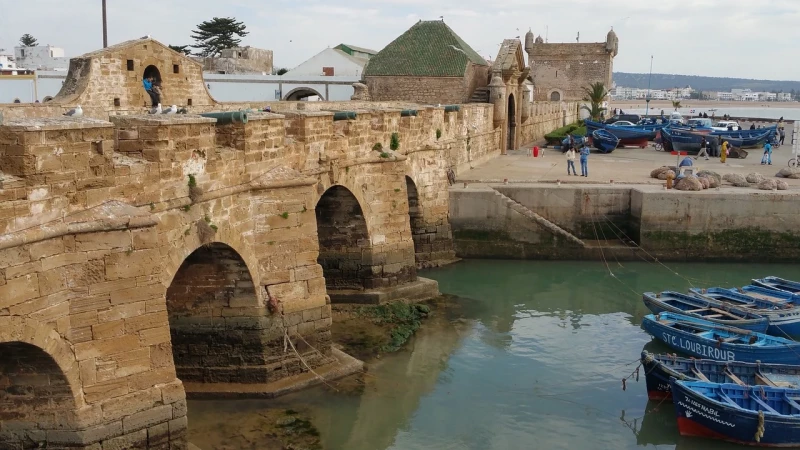
Visiting Essaouira, perched on the Atlantic coast of Morocco, is an immersion into history, culture, and coastal beauty. This port city, a UNESCO World Heritage site, captivates with its unique charm, blending Arab, Berber, and European influences. The medina of Essaouira unveils winding alleyways where one can explore shops of talented artisans, art galleries, and picturesque cafes.
Essaouira's ramparts offer breathtaking views of the Atlantic Ocean and the medina. The bustling port is a lively scene, with fishermen unloading their daily catches and brightly blue boats swaying gently with the waves. Essaouira's beach, conducive to relaxation, beckons visitors for moments of serenity facing the ocean.
Seafood enthusiasts will be delighted by the culinary delights of the port, where fresh fish and seafood are prepared before you in coastal restaurants. The Skala de la Ville, a historic fortress, provides spectacular panoramic views and a tranquil atmosphere.
Essaouira also pulsates to the sounds of music festivals, attracting artists from around the world. In essence, a visit to Essaouira is an invitation to explore authenticity, savor local gastronomy, stroll along the ramparts, and succumb to the enchanting charm of this Moroccan coastal city.
 Our tips for getting the most out of your experience.
Our tips for getting the most out of your experience.
When planning a day trip to Essaouira, here are some tips to maximize your experience:
-
Early Departure: Start your day early to make the most of your time in Essaouira. Streets are often quieter in the morning, providing a peaceful atmosphere.
-
Comfortable Transportation: Ensure you have comfortable transportation for your day trip. Whether you opt for a car, bus, or private vehicle, comfort is crucial for an enjoyable day.
-
Attraction Planning: Identify in advance the attractions you want to visit in Essaouira. This will allow you to optimize your time and ensure you don't miss key sites.
-
Explore the Medina: Explore Essaouira's medina on foot. The narrow streets are filled with artisan shops, art galleries, and charming cafes. Don't be afraid to venture off the beaten path.
-
Beach Time: Reserve time to enjoy Essaouira's beach. It's the perfect place to relax, take picturesque photos, and maybe even try a camel ride.
-
Seafood Meal: Don't miss the chance to taste fresh seafood at one of the port-side restaurants. Choose an establishment with an ocean view for an even more enjoyable culinary experience.
-
Visit the Ramparts: Climb Essaouira's ramparts for impressive panoramic views of the city and the ocean. It's an excellent way to capture memorable photos.
-
Free Time: Allow yourself some free time to wander through the souks, shop, and appreciate the laid-back atmosphere of Essaouira. Let yourself be carried away by the magic of this coastal city.
-
Stay Flexible: Remain flexible in your schedule. Some of the most memorable experiences can result from spontaneous discoveries or unexpected moments.
-
Evening Return: Plan to return in the evening to enjoy the sunset on the way back. Sunsets in Essaouira can be spectacular.
By following these tips, you can have a rewarding day in Essaouira, explore its unique charms, and make it a memorable day trip from Marrakech.
11 - The Agdal and Menara Gardens
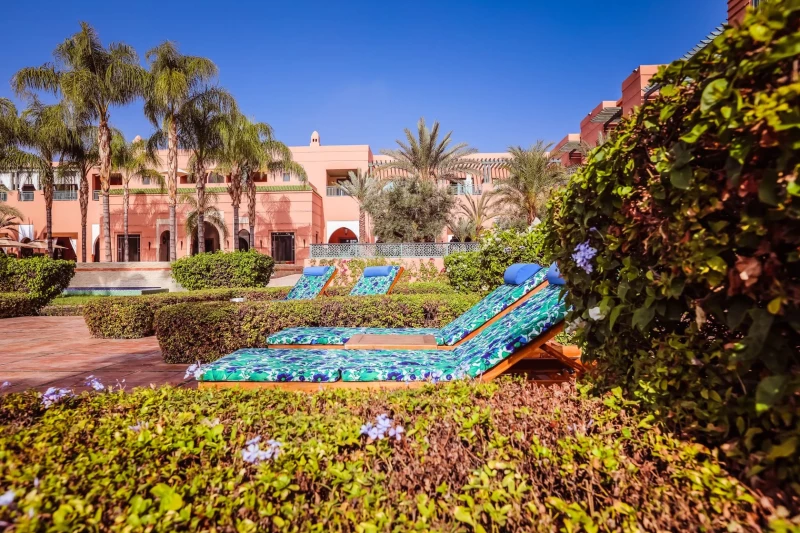
The Gardens of Agdal and Menara, situated in Marrakech, are two green gems that testify to Morocco's historical richness and natural splendor.
The Agdal Gardens, part of the royal palace, are historic gardens dating back to the 12th century. They provide an oasis of serenity with shaded alleys, fountains, basins, and meticulously maintained flower beds, creating a peaceful atmosphere away from urban bustle.
The Menara Gardens, also dating back to the 12th century, are characterized by a vast irrigation pool surrounded by majestic olive trees. The location offers panoramic views of the Atlas Mountains, creating a picturesque landscape. Historically, the gardens were used as a relaxation spot for rulers, providing a haven of peace adorned with traditional Moroccan architecture.
These gardens not only showcase architectural and landscaping prowess but are also steeped in history, serving as silent witnesses to bygone eras. By visiting the Gardens of Agdal and Menara, visitors have the opportunity to immerse themselves in Morocco's natural beauty and feel the tranquility that pervades these lush oases in the heart of Marrakech.
 Our tips for getting the most out of your experience.
Our tips for getting the most out of your experience.
When visiting the Gardens of Agdal and Menara in Marrakech, here are some tips to enhance your experience:
-
Visiting Hours: Plan to explore the gardens early in the morning or late in the afternoon to avoid the intense midday heat and enjoy softer lighting.
-
Comfortable Footwear: Wear comfortable shoes to allow for easy walking on the garden's paths, which can be paved or earthen.
-
Sun Protection: Bring sunscreen, a hat, and sunglasses to protect yourself from the sun, especially if you plan to spend a significant amount of time outdoors.
-
Drinking Water: Carry a water bottle to stay hydrated during your visit, especially in warm weather.
-
Leisure Time: Allocate some leisure time to sit, relax, and soak in the peaceful atmosphere of the gardens. It's an ideal spot for a quiet break.
-
Camera: Don't forget to bring your camera to capture the beautiful landscapes and architecture of the gardens.
-
Explore Every Corner: Take the time to explore every corner of the gardens, as they often hold interesting architectural details and picturesque viewpoints.
-
Learn about the History: Familiarize yourself with the history of the gardens before your visit. This will enrich your experience by understanding the cultural and historical context.
-
Local Guides: If possible, hire a local guide. They can provide detailed information about the history, architecture, and cultural significance of the gardens.
-
Respect Garden Rules: Respect the rules and information signs in the gardens. This helps preserve the natural and historical beauty of the site.
By following these tips, you can fully appreciate the tranquil beauty of the Gardens of Agdal and Menara in Marrakech.
12 - Agafay Desert and Sunset
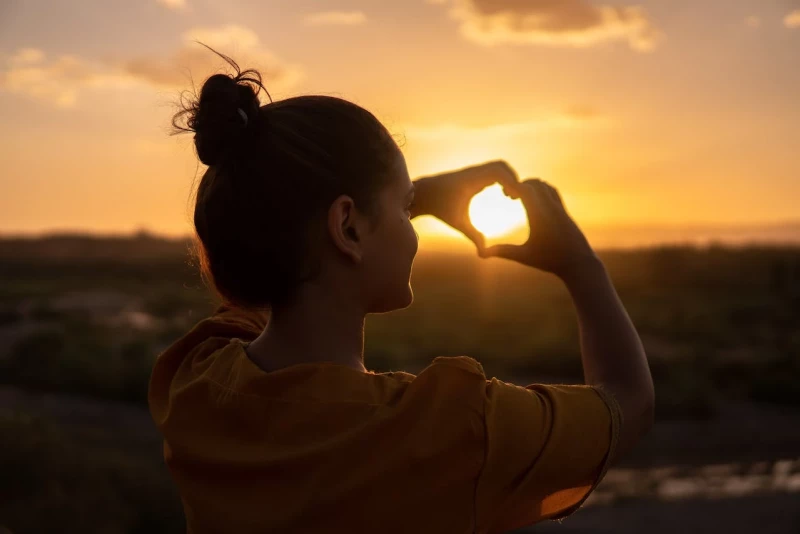
The Agafay Desert, an oasis of tranquility near Marrakech, offers an enchanting escape from urban hustle. Unlike a traditional desert, Agafay is characterized by stretches of rocks and arid hills, creating a captivating lunar-like landscape. The silent vastness of the desert creates a peaceful atmosphere, perfect for those seeking serenity and a change of scenery.
At sunset, Agafay transforms into a spectacle of dazzling colors. Golden and orange hues ignite the sky, casting dramatic shadows on the rocky hills. Travelers have the opportunity to settle on comfortable Berber cushions and gaze at the magnificent panorama as the sun slowly retreats on the horizon.
Some nomadic camps offer nighttime experiences, allowing visitors to spend the night under the sparkling desert stars. It's a unique opportunity to connect with nature, savor local cuisine prepared around the campfire, and immerse oneself in Berber culture. Thus, the Agafay Desert and its sunset offer an enchanting getaway, revealing the ephemeral and timeless beauty of Morocco.
 Our tips for getting the most out of your experience.
Our tips for getting the most out of your experience.
When planning an experience in the Agafay Desert with a sunset in Marrakech, here are some tips to make the most of it:
-
Book a Guided Tour: Opt for an organized tour with a local guide. This will provide you with in-depth information about the region, local culture, and ensure a safer experience.
-
Appropriate Clothing: Wear lightweight and comfortable clothing, but bring an extra layer for cooler evenings. A scarf may also be useful to protect your face from the wind.
-
Comfortable Shoes: Choose comfortable shoes for walking on the varied terrain of the desert. Open sandals might be suitable, but closed shoes are recommended for increased protection.
-
Hydration: Bring enough water to stay hydrated, especially if you plan to stay for the sunset. Deserts can be dry, even in the evening.
-
Sun Protection: Use sunscreen to protect yourself from the sun's rays, especially if you plan to spend a lot of time outdoors.
-
Camera: Don't forget to bring a camera to capture the magical moments of the sunset. The landscapes and lighting in the desert can be spectacular.
-
Blanket or Scarf: Consider bringing a light blanket or scarf to protect yourself from the wind during the evening.
-
Learn about Local Customs: Familiarize yourself with local customs and follow the advice of your guide to respect the environment and culture of the desert.
-
Nighttime Experience: If possible, explore a nighttime experience with a night under the stars. Some camps offer traditional Berber accommodations for a deeper immersion.
-
Be Ready for the Unexpected: Deserts often offer surprises. Be open to the unexpected, whether it's encounters with local wildlife or extraordinary lighting during the sunset.
By following these tips, you can ensure an unforgettable experience in the Agafay Desert, especially during the magnificent sunset that characterizes this region.
13 - the Berber villages of the Ourika valley
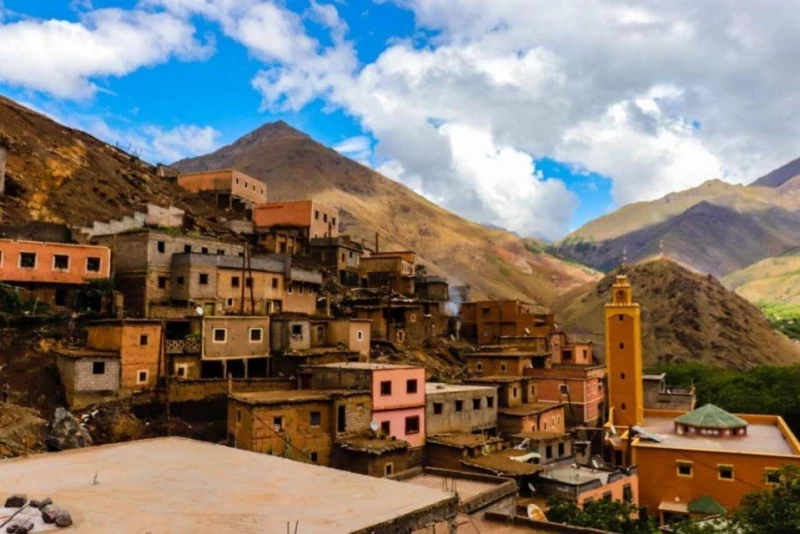
The Ourika Valley, nestled in the foothills of the Atlas Mountains, is home to a series of Berber villages that provide an authentic immersion into Moroccan rural life. These villages proudly preserve centuries-old traditions of Berber culture, featuring adobe houses in ochre tones, narrow alleyways, and vibrant markets where local artisans display their handmade products.
The valley is adorned with spectacular landscapes, lush gardens, and winding rivers, creating a picturesque setting. The welcoming locals willingly share their way of life with visitors, offering warm hospitality and enriching cultural exchanges.
Each village has its unique charm, whether it's Setti Fatma, renowned for its refreshing waterfalls, or Tnine de l'Ourika, providing breathtaking views of the surrounding mountains. Hiking through these villages allows for the discovery of artisanal traditions, such as the crafting of Berber carpets, and an opportunity to savor authentic local cuisine.
The Ourika Valley and its Berber villages make for a perfect getaway from Marrakech, offering a tranquil respite in an exceptional natural setting and an immersive experience into the culture and daily life of Moroccan Berbers.
 Our tips for getting the most out of your experience.
Our tips for getting the most out of your experience.
When planning to visit the Berber villages of the Ourika Valley, here are some tips to make your experience richer and enjoyable:
-
Local Guides: Hire a local guide to accompany you through the villages. They can provide in-depth cultural insights, facilitate interactions with locals, and show you less-traveled areas.
-
Respect Local Culture: Familiarize yourself with local customs and show respect for Berber culture. Ask for permission before taking photos and be aware of traditions and social norms.
-
Appropriate Clothing: Wear modest and appropriate clothing, especially if you plan to visit more traditional areas. Scarves can also be useful for sun protection.
-
Meet the Locals: Don't miss the opportunity to meet the locals. A simple greeting or a small conversation can often create memorable moments and enriching cultural exchanges.
-
Explore on Foot: Walking through the villages allows you to discover architectural details, local markets, and picturesque corners you might otherwise miss.
-
Taste Local Cuisine: Sample authentic Berber cuisine. Villages are filled with small restaurants where you can taste traditional dishes made with local ingredients.
-
Hike to Waterfalls: If visiting Setti Fatma, be prepared for a short hike to the waterfalls. Ensure you have comfortable shoes and bring water.
-
Responsible Shopping: If you make purchases, prioritize local artisanal products. This contributes to supporting the local economy.
-
Visiting Hours: Try to visit the villages early in the morning or late in the afternoon to avoid the midday heat and to capture the beauty of the lighting during these hours.
-
Be Mountain-Ready: If exploring villages at higher altitudes, ensure you are prepared for temperature changes. A light jacket may be necessary even in the summer.
By following these tips, you can turn your visit to the Berber villages of the Ourika Valley into an authentic and memorable experience.
Marrakech - Where to Stay?
In Marrakech, several neighborhoods offer accommodation options catering to different tastes and preferences. Here are some suggestions to help you choose the location that best suits your needs:
-
Medina: For an authentic experience: Choose a traditional riad in the heart of the Medina, close to the souks, Jemaa el-Fna square, and major historical attractions. This provides total immersion in the charm of the old city.
-
Gueliz: For a modern atmosphere: Gueliz is Marrakech's modern district with chic shops, trendy restaurants, and cafes. It's an excellent choice if you prefer a more contemporary environment while still staying close to the city center.
-
Hivernage: For luxury and relaxation: Hivernage is known for its luxury hotels, high-end spas, and trendy clubs. It's a quieter neighborhood than the Medina, ideal if you're looking for an elegant and peaceful atmosphere.
-
Palmeraie: For exclusivity: Palmeraie offers hotels and riads surrounded by palm trees, creating a peaceful and luxurious atmosphere. It's a perfect choice if you seek a more secluded and upscale getaway.
-
Kasbah: For a compromise: Kasbah is an intermediate option between the Medina and Hivernage. It provides easy access to the Medina while offering a quieter atmosphere. You'll also find traditional riads in this area.
-
Agdal: For a family stay: Agdal is a residential neighborhood with family-friendly hotel complexes. If you're traveling with family, it's an ideal place often equipped with facilities for children.
When choosing your accommodation, consider your preferences regarding style, budget, ambiance, and proximity to the sites you want to visit in Marrakech. Whether you opt for the historic Medina, the modern comfort of Gueliz, or the elegance of Palmeraie, Marrakech offers a variety of options for all types of travelers.
Marrakech - How to get around?
In Marrakech, there are various transportation options to facilitate your movement around the city. Here are some common means of transportation:
-
On Foot: Most attractions in Marrakech, especially in the Medina, are easily accessible on foot. Strolling through narrow streets allows you to discover numerous markets, shops, and historical sites.
-
Horse-Drawn Carriages (Caleches): Horse-drawn carriages, known as caleches, are popular for romantic rides or traditional city exploration. You can find them mainly around Jemaa el-Fna square.
-
Taxis: Taxis are abundant in Marrakech. Ensure the driver uses the meter or negotiate the fare before getting in. Taxis can be useful for longer trips or reaching places outside the Medina.
-
Tuk-Tuks: Tuk-tuks, small motorized vehicles, are also available for short rides around the city. Negotiate the fare before departure.
-
Bicycle and Scooter Rentals: You can rent bicycles or scooters for greater mobility. This can be particularly convenient for exploring neighborhoods beyond the city center.
-
Buses: Marrakech has a public bus network covering different parts of the city. However, buses may be less frequent and less convenient for tourists.
-
Car Rental: If you want to explore the outskirts of Marrakech or plan excursions in the surrounding areas, car rental can be a convenient option. However, traffic can be dense, especially in the Medina.
-
Uber: Uber is also available in Marrakech, providing an alternative to traditional taxis with often preset fares.
It is advisable to combine several modes of transportation based on your specific needs. Keep in mind that the Medina is mostly pedestrian, and to access it, it's often preferable to walk or use non-motorized modes of transport.
Marrakech - Best period
The best time to visit Marrakech depends on your preferences for climate and activities. Here is some information about the seasons in Marrakech:
-
Spring (March to May): Spring is often considered the best time to visit Marrakech. The temperatures are pleasant, with sunny days and mild nights. Gardens are in bloom, and the city is lively but not as crowded as during the peak tourist season.
-
Summer (June to August): Summer in Marrakech can be very hot, with temperatures often exceeding 40°C (104°F). It's the high tourist season, but the hot afternoons can make outdoor sightseeing challenging. However, nights are generally milder.
-
Fall (September to November): Fall is another pleasant time to visit Marrakech. Temperatures start to cool down, but remain comfortable. It's an ideal time for exploring the city and its surroundings, as well as participating in festivals and cultural events.
-
Winter (December to February): Winter temperatures are generally mild during the day but can be cool in the evenings. It's a popular season to visit Marrakech, but be prepared for cooler evenings.
In summary, spring and fall offer an ideal balance of pleasant temperatures and more moderate tourist crowds. However, if you prefer warmer temperatures and don't mind the heat, summer can also be an option, especially if you want to enjoy the long, mild evenings. Avoid July and August if you are sensitive to intense heat.

